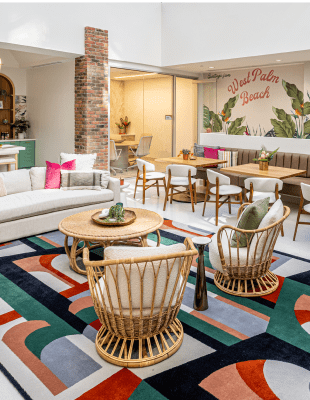Hurricane and severe storm preparedness – already a complex process – is more challenging than usual this year. Effectively protecting all citizen groups will require innovation.
The 2020 hurricane season is moving at an above-average pace. Tropical storm Gonzalo was the earliest G-named storm ever for the Atlantic Hurricane season, and NOAA expects 3-6 major storms on the Atlantic seaboard this year. In addition, Iowa just experienced significant impacts from a severe storm that released hurricane-like effects. Like everything else in 2020, supporting citizens with shelter, transportation and medical care during severe storms – already a complex process – will be even more trying than usual.
The economic effects of COVID-19 are leaving people, especially vulnerable and underserved groups, and businesses with fewer resources to prepare. In addition, political and civil rights tensions are at fever pitch across the nation. Facing multiple concerns at once, communities must innovate hurricane preparedness plans. But what must change? And how might it happen? In addition the threat of illness and hurricanes, there are very real political and civil rights tensions dominating the American landscape right now. These concerns will particularly affect sheltering, evacuations, trust in government, and trust between citizens.
Inspire a whole community approach
Sarah Moore, Senior Management Consultant
What needs to change
Preparedness and resilience-building must be part of our culture. Community-level plans are more effective when people act at home and in the workplace as part of a thoroughly integrated response. Reaching citizens on a personal level can be a real challenge.
Millions of dollars have been spent trying to drive the preparedness message home, but research shows that most people will not act to mitigate a risk until the threat becomes tangible. Reaching them early can make an incredible difference.
Adding to this challenge, vulnerable communities are subsisting on less income than usual because of COVID-19. The public agencies and nonprofits that would otherwise provide relief are also seeing staff and budget cuts. Can we expect a family struggling with bills and disruption to spend money on resources preparing for another disaster? When we are already in crisis, it is difficult for individuals (and organizations) to adapt to changing circumstances.Plans need to consider other ways to encourage preparedness while also providing resources to people also in the thick of a pandemic or contentious protests.
Other planning areas will change as well. For example, the supply chain for equipment and resources might be different or include new items like personal protective equipment and additional cleaning materials. Places that receive evacuated citizens will need to revisit plans to accommodate social distancing. Those changes could be significant.
How to make the change
The first step is to identify new needs: Are your resources the same? Can you evacuate to the same places you used to? Are your equipment and supply chain different? Use the latest CDC and FEMA guidance to develop effective answers to these questions. Also, reach out to parties who may be affected and jurisdictions that you may partner with to ensure safe evacuations.
Maximizing public-private partnerships can help stock or track supplies, especially items that have not been needed much in the past, like masks. Volunteer organizations in active disasters (VOAD) will continue to be crucial to ensuring strong communication pathways and planning for multiple scales of need.
Another innovative idea is the person-to-person share economy. On a corporate level, shared mobility and housing has helped provide disaster relief in the past, with companies covering the costs of transporting and housing evacuees. If we take that further to a person-to-person level, social media or apps can connect citizens for lending, trading, and donating supplies, rides, or shelter. This would mean quick and direct access to what they need, and, considering COVID-19, smaller groups sharing rides, shelter and resources would lessen large gatherings. Now is the time to investigate and build those networks, both as public officials and citizens.
Connect with all citizens to maximize equity
Ajani Stewart, Senior Management Consultant
What needs to change
Without question, a critical piece of the whole community approach is equity. According to a study conducted by the Brookings Institute, “low-income and minority communities are more vulnerable to the risks of natural disasters, and they also struggle most to recover.” Additionally, the CDC points out that “long-standing systemic health and social inequities have put some members of racial and ethnic minority groups at increased risk of getting COVID-19 or experiencing severe illness, regardless of age.” Vulnerable populations face compounding risks.
These realities highlight the need for proactive approaches that are inclusive, empathetic, and sustainable. We recognize this is easier said than done. In response to shocks (e.g., a hurricane, pandemic, economic crisis, or all three at once), people tend to run down the pathways they are most familiar with. Unless equity is ingrained in the way we train, exercise and plan under “blue sky” conditions, it will be impossible to employ during a crisis. Instead, we will revert back to what we have practiced most: logistically meeting baseline needs for as many people as possible. Despite best intentions, the needs of vulnerable or underserved groups will remain unmet.
In addition to the threat of illness and hurricanes, there are very real political and civil rights tensions dominating the American landscape right now, particularly related to sheltering, evacuations, trust in government, and trust between citizens. These tensions add a layer of complexity to protecting the health, safety and wellbeing of our communities. Resilience and emergency preparedness professionals may not be able to change hearts and minds, but we can play a role in helping people see the best in one another. More inclusive community-wide conversations will lead to more robust solutions.
How to make the change
Planning should be a two-way conversation with citizens, especially those who are underserved. Truly effective engagement builds trust, evokes change in all parties and creates outcomes aligned with people’s needs. Get out and meet the people where they are.Sarah mentioned the value of connecting with local VOADs for supplies; these organizations can also be a wealth of information for planning. Their connections with special and underrepresented populations can broaden your reach to underserved corners of the community.
Perform due diligence without assumptions. Do not take anything for granted – certain citizens might not have a network of family or friends, consistent internet access or other advantages that serve as the foundation for many people’s emergency plans. The typical beacons for alerting citizens, for example, might not have the reach that planners believe they do. Work with trusted advisors for the communities you wish to serve to better understand the best way to reach them.
Another aspect of this is flexibility. Often, teams will conflate a hypothesis with a position, treating a prescribed solution as the be-all, end-all solution. The middle of a crisis is not the best time to put that to the test, and an even worse time to realize it is not the answer to all your problems. The more work you do ahead of time to test that hypothesis, the better. Flexibility is a facet of innovation, and there are times where asking different questions will lead to better solutions. Test new ideas alongside tried and true methods to understand their effectiveness, then adjust as needed.
Embrace data-driven decision-making
Trevor Johnson, Senior Resilience Planner
What needs to change
Some communities start thinking about data when the storm is closing in. But the days leading up to a major hurricane are not the time to think about data you need to inform decisions. Preparations can be maximized by having complete, current and trusted data accessible to key personnel. These data can drive decisions that prioritize the health, safety and wellbeing of the entire community.
The key data needs extend beyond flood inundation and hazard models. They include elements such as the elevation of critical infrastructure and facilities that support community lifelines, as well as the locations of populations most socially or economically vulnerable to hurricane impacts. All organizations involved in planning and responding will benefit from assembling these data in advance in order to prioritize actions and economize limited resources.
The COVID-19 pandemic is an example of how non-weather-related insights can also help inform hurricane preparedness plans. Understanding the number and location of cases relative to areas that may be affected by a storm will promote safer evacuation procedures and enable contact tracing to limit the potential spread of infections. Layering data can reveal optimal solutions for ensuring everyone’s well-being, whether the biggest threats are weather- or pandemic-related.
How to make the change
Find ways to combine and collaborate over risk data with partner agencies and organizations at the local, regional, state and federal levels. A platform for resilience and preparedness specialists, emergency response teams and public officials to share insights can help all parties understand and respond to all risks around a weather event. An example approach can be found in the statewide data gap analysis completed by the Louisiana Watershed Initiative last year. In it, data availability, access and quality were evaluated across numerous federal, state, regional and local entities to support resource allocation, decision-making and data access.
Part of this involves sourcing useful data. COVID-19 data, for example, can be taken from public health officials or the CDC. Population data from the Census Bureau as well as state and local sources can help identify the greatest needs and help rapidly direct resources at appropriate times. Government organizations, community groups or even the private sector could provide analysis of these and other risk data to strengthen resilience plans. To ensure usefulness, all data should be vetted for quality and privacy considerations.
For sharing information with the community, citizens will need up-to-date information around preparedness steps, evacuation orders, shelter locations and COVID-19 safety.
Transparency is key. Getting the word out means leveraging a variety of channels including websites, social media, local TV and radio, community meetings and whatever else is available.
ABOUT THE AUTHORS
Carly Foster, Expert Management Consultant
Carly helps clients build resilience at all scales and through every phase of resilience building. She’s supported $6 billion worth of funding in U.S. resilience projects, helping them advance from ideation to completion. Notable projects include Climate Ready Boston, which received the APA National Resilience Award, and the Louisiana Watershed Initiative.
Working in resilience, Carly’s specialty is connecting threads. She recognizes how to leverage mutual interests to connect stakeholders, where to find opportunities to connect infrastructure, and how to quantify the impacts of asset losses on end users. These connections enhance resilience project capabilities to improve quality of life for all.
Edgar Westerhof, National Director for Flood Risk & Resilience
Edgar helps clients analyze and apply strategic best practices for resilience. By dissecting the multiple layers of resilience challenges, he helps pinpoint optimal improvement opportunities. He led The East Side Coastal Resiliency project – also known as the Big U – which integrated multifunctional resiliency solutions to provide flood protection around Manhattan.
Edgar ensures organizations are targeting their most important needs. He’s an expert in helping clients find the right resilience questions to ask, then developing long-term answers.






